Carrara, the world capital of marble, a city with a history spanning thousands of years, nestled among quarries in the Apuan Alps, a city that stretches from the mountains to the sea, dominated by the imposing bulk of Mount Sagro, the sacred mountain of the Apuan Ligurians who were the first inhabitants of these lands. “Lunge per l’aria chiara / appar grande e soave / cerula e bianca / l’Alpe di Carrara, / cerula d’ombre / bianca di cave”: so sang Gabriele d’Annunzio, among the many literati and artists who could not resist the charm of this unique city, made of marble, and whose life revolves around its most prized material. Located on the Apuan Riviera, on the border with Liguria, it is in the far north of Tuscany, but of Tuscan it has only its administrative affiliation: its historic center, with its colorful houses, is more reminiscent of those in Liguria, its inhabitants speak a strange dialect that is a mixture of Ligurian and Emilian (and is actually considered by linguists to be an Emilian dialect), and its history has almost always been linked to that of nearby Massa (together, Massa and Carrara were the main centers of an independent state, the Duchy of Massa and Principality of Carrara, which came into being in 1473 and ended in 1836 when its territories ended up under Modena). A peculiar and little-known city, a shadowy and fascinating city with many hidden faces, the capital of anarchy, filled with works of art, and rich in the evidence that the history of marble has left behind, Carrara is definitely worth a visit for so many reasons. We give you at least ten, since we know it very well(Finestre Sull’Arte was born in Carrara): here are the ten places you should not miss during your visit to Carrara.
Famous all over the world, the marble quarries form a white crown that wreathes the historic center of Carrara and the villages upstream. Marble quarrying has an ancient history, beginning with the Romans, who used Apuan marble for many of Rome’s most splendid monuments, from the Pantheon to the Forum of Trajan, from the Arch of Domitian to the Pyramid of Cestius: at the time, it was pulled down from the mountains by ox-drawn carts and then shipped to the port of Luni. Today there are more than eighty active quarries divided into the three marble basins of Torano (which also includes that of Pescina-Boccanaglia, sometimes considered a separate basin), Miseglia, and Colonnata: the quarries are located at high altitude, are reached by winding roads (some of which are accessible only to authorized vehicles), and may be open pit or underground. Some quarries can be visited, always keeping in mind that they are workplaces. The marble, reduced into blocks, is then transported downstream by road vehicles and then loaded onto port ships, which will transport it around the world. Some, on the other hand, remains on site to be worked by artisans and artists (the list of contemporary and ancient artists who have passed through the quarries is long, from Michelangelo to Canova to the present day with names such as Maurizio Cattelan and Jeff Koons, who choose Carrara workshops for their marble works), but the marble has many different uses: in construction, urban planning, design and furniture, and industry. A visit to the quarries, if you come to Carrara, is not to be missed.
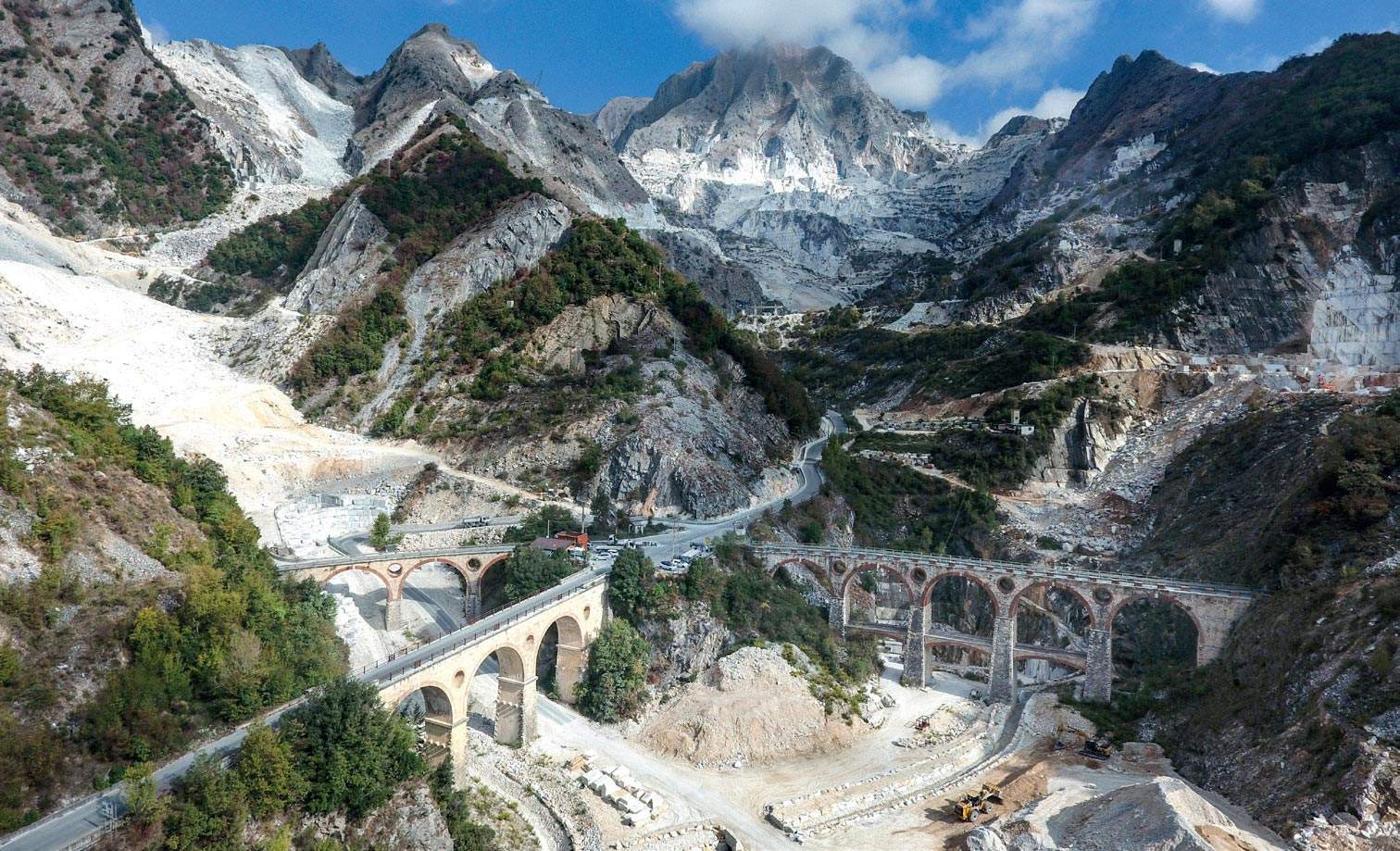
Carrara’s historic center, nestled along the banks of the Carrione stream, is one of the most stratified in this part of Tuscany, and its urban developments are clearly recognizable. Around the cathedral, the central Via Santa Maria, and in the picturesque neighborhoods of Caffaggio and Grazzano, the medieval core, the oldest one, can be recognized. Between Piazza dell’Accademia and Piazza Alberica, on the other hand, it is possible to stroll through the streets of the more orderly Renaissance core, and finally the area around Via Roma, Via Verdi and Via Cavour, where many of the city’s most elegant palaces stand, is the nineteenth-century one, which marked the last major expansion of the historic center. One then walks through the narrow medieval alleys that start from Piazza del Duomo and climb toward the large, 19th-century Piazza Gramsci (the ancient Piazza d’Armi), one can linger in one of the elegant cafes of Via Roma, the main street of the city’s struscio, or you can admire the seventeenth- and eighteenth-century palaces of Via Loris Giorgi (such as the very special Palazzo delle Cariatidi) until you reach Theater Square, on which stands the neoclassical Teatro degli Animosi or to Piazza dell’Accademia, dominated by another singular building, the Cybo-Malaspina Palace, divided into two nuclei, the Rocca Malaspina, medieval but renovated in the early 20th century, and the 16th-century Palazzo del Principe (now the home of the Academy of Fine Arts). But there is much more to discover in one of Tuscany’s most beautiful and seductive historic centers: simply walk its streets.
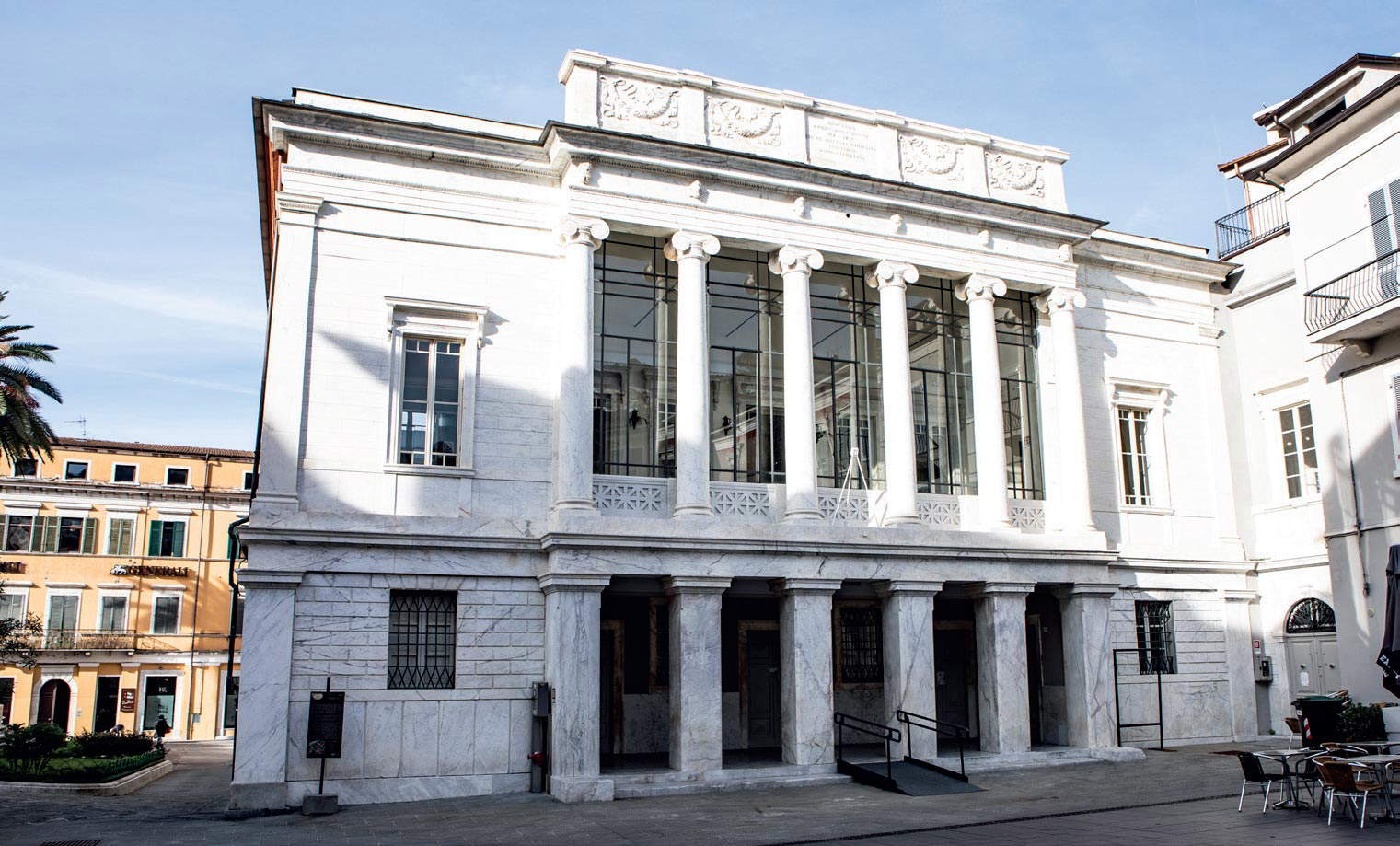
Dedicated to St. Andrew, Carrara Cathedral is first mentioned in 1099 but perhaps its history is even older. It is one of the most spectacular buildings of worship in Tuscany: built entirely of marble, it has followed at least three phases of construction, one in the 11th century dependent on Parmesan ways, one between the 12th and 13th centuries in which the Lucchese direction prevails, and one in the 14th century characterized by Pisan architecture, that is, the one that determined the style of its Romanesque-Gothic facade with black and white banded marble, where the splendid 14th-century rose window stands out. On the outside one can admire the 13th-century bell tower, in Ligurian style, and the marvelous portals decorated by sculptors from Parma, in Romanesque style, rich with human and animal figures, a veritable stone Bible that continues inside. The latter, austere, divided into three naves, still retains its Romanesque-Gothic appearance and holds important works of art: the painted cross from the second half of the 14th century attributed to Angelo Puccinelli, the “Cassanelle,” or the 14th-century sculptural group of the Pisan school depicting the Annunciation, and then again the Martyrdom of St. Ceccardo by Luciano Borzone, the statue of the Madonna of the Assumption attributed to Simone Moschino, the Madonna of the Rosary by Giovanni Antonio Cybei, the Madonna with Saints group by Andrea Guardi, and much more. Finally, in Piazza del Duomo, you can admire the statue of the Giant, an unfinished work by Baccio Bandinelli, commissioned as a portrait for Andrea Doria but then left in Carrara.

This is the monumental heart of downtown Carrara. The work that led to the opening of Piazza Alberica began in 1574 at the behest of Prince Alberico I Cybo-Malaspina, who wanted to transform a meadow formerly used for cattle trading into a modern square flanked by porticoes and palaces. Shaped like a trapezoid, it is distinguished by its paving, a marble pavement divided into ten sectors (six of which are decorated with the wheel, the symbol of Carrara), and by the elegant palaces that enclose it on all sides, starting with the most conspicuous, Palazzo Del Medico, former residence of the noble Carrara family of the same name, now partly used for private residences and partly, on the main floor, a cultural venue: the Vôtre space, a dynamic contemporary art center that organizes year-round exhibitions of major national and international artists, is located here. On the opposite side stand the 17th-century Palazzo Pisani and, toward the Baroncino bridge, the scenic Palazzo delle Logge, another ancient noble residence (it belonged to the Diana family). In the center of the square, on the other hand, stands the monument to Maria Beatrice d’Este, duchess of Massa and princess of Carrara between 1790 and 1796, and then again between 1814 and 1829: it is the work of the Carrarese sculptor Pietro Fontana.
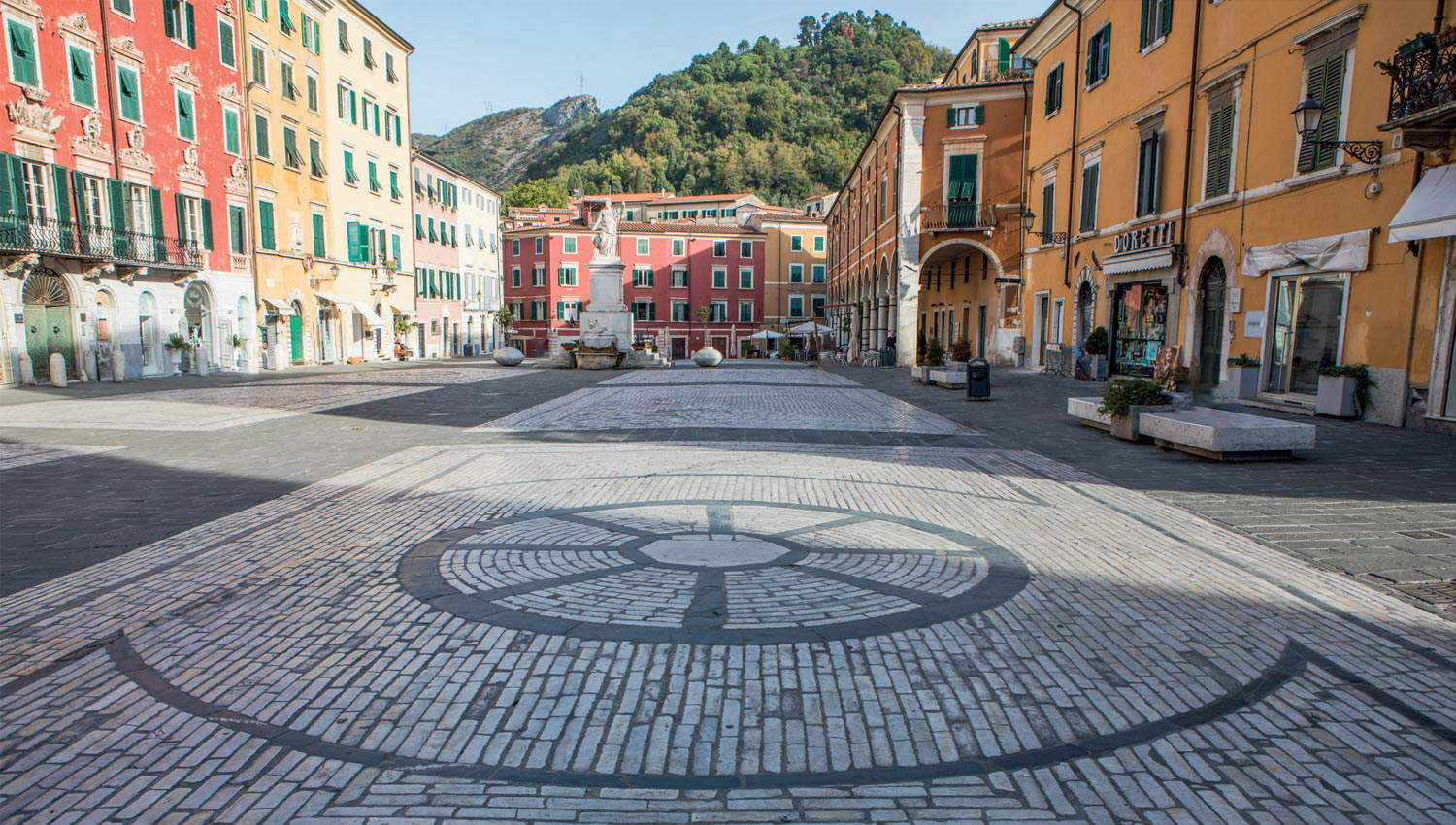
Via San Piero is one of the most picturesque alleys in the historic center: it is located near the Teatro degli Animosi, a magnificent neoclassical building, and is linked both to the history of anarchy (Carrara, as mentioned in the opening, is considered the Italian capital of anarchy because here anarchist thought has solid and widespread roots, both because of the city’s history, linked to the harsh living conditions of quarrymen, and because of the proud and indomitable nature of its inhabitants) and to the street art scene. The Cooperativa Tipolitografica, where the most important voices of Italian anarchism are still printed, is based here, and the murals of many street artists, from the most famous ones such as Ozmo to the emerging ones, can be found here.Starting in 2018, on the initiative of the Circolo dei Baccanali (thanks to its project Adopt an alley), they have made Via San Piero a kind of temple of street art that was born and grew freely and spontaneously and soon became a destination for many fans.

It is located about three kilometers from the historic center, on Viale XX Settembre, near the Stadium. The Marble Museum is the main reference point for learning about the history of the material that has made Carrara famous throughout the world. It is the city’s first public museum and has been housed, since its opening in April 1982, in a building that represents one of the best Italian examples of organic architecture and was built between 1962 and 1965 to a design by Dante Petrucci and Ezio Bienaimé. The structure was initially designed to house the National Marble Exhibition, then became the headquarters of the Internazionale Marmi e Macchine, and finally rediscovered its exhibition vocation and became definitively, under the coordination of Enrico Dolci who conceived its museological project, the site of the city’s first museum, entirely dedicated to the history of marble. The tour is divided into thematic areas: the visitor will learn about the history of the territory and the Apuan Alps with the help of various geomorphological models, and through marble reproductions and furnishings the importance that marble possesses for the territory will be highlighted. Two ancient techniques for transporting marble blocks downstream are also shown: the lizza pulled by two pairs of oxen and the Roman cart. There is also a section on Roman archaeology and the link between marble and the city of Luni, and one on industrial archaeology. The museum also has more than three hundred large-format specimens of the most prestigious commercial marbles arranged in the Marble Museum’s Marble Library, while the Technical Applications room, with its display of the Third National Marble Exhibition of 1968, shows how marble can be used as a furnishing element or as an interior and exterior cladding for buildings. As for Carrara’s museum scene, also worth mentioning are the Museum of Contemporary Art, which houses the municipal art collections (mostly sculptures made during the Carrara Biennials), and Palazzo Cucchiari, home of the Giorgio Conti Foundation, which periodically hosts high-level exhibitions of ancient art.
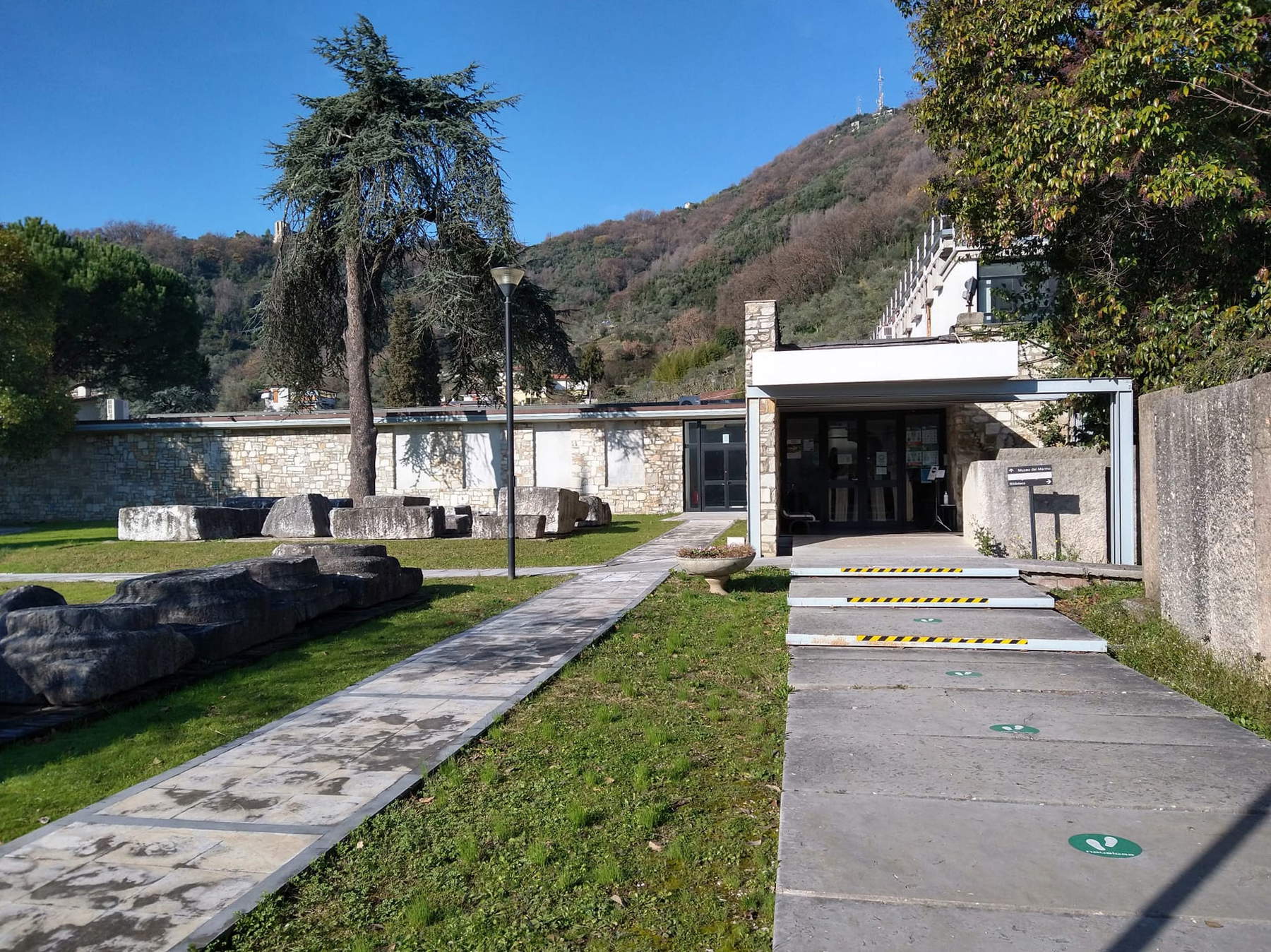
A sort of Staglieno in miniature: this is the monumental cemetery of Marcognano, which started as a small suburban cemetery and became a large terraced cemetery between 1885 and 1896 as a result of Leandro Caselli’s interventions. Its structure is made entirely of Carrara marble. One can admire lavish chapels, which often take on the appearance of temples in a wide variety of styles, from classical (such as the Nicoli and Berring-Nicoli chapels), neo-Gothic (for example, the Cucchiari, Forti and Salvini chapels). There are even chapels, such as the Mattioli and Triscornia, in the Egyptian style. And of course, Marcognano abounds with works of art: the most famous is probably the angel that adorns the burial of Mario Pisani and Clotilde Bernabò Corradi, but also fascinating are the angel in the Berring-Nicoli chapel, who brings his hands to his chest with a distressed air, the pensive bronze angel that adorns the Nicoli chapel, and the one astride the tomb of Erminia Maggesi. Also very intense are the monument to the very young schoolteacher Assuntina Dini, with an epigraph by the poet Ceccardo Roccatagliata Ceccardi, and the monument to the quarrymen who fell during the tragedy of Mount Bettogli in 1911, when a landslide killed ten workers, some of them very young.

Everyone will undoubtedly have heard of Colonnata, associating it with its most famous product: lardo, the PGI cured meat produced in the marble basins kept in the artisanal workshops that dot this quaint quarrymen’s village. Colonnata is the town’s highest upstream hamlet, at 532 meters above sea level (it can be reached in about a quarter of an hour from the historic center of Carrara, via a convenient road that snakes through the marble quarries, affording here and there memorable glimpses and views), and it retains intact its ancient appearance, with its sober but marble-decorated buildings, the surprising little central square also all paved in marble, the church of San Bartolomeo (the 16th-century crucifix inside, probably of the Michelangelo school, is worth seeing), and the monument to the quarryman created in 1983 by Alberto Sparapani. And finally, a stop at one of the many larderies to taste the not-to-be-missed Colonnata lard.

This is the church in the hamlet of Avenza, which is located between the historic center and Marina di Carrara (in ancient times it was in Avenza that the coast arrived). It stands not far from the 14th-century Castruccio Tower (which is what remains of the fortress built in Avenza by the condottiero Castruccio Castracani between 1319 and 1328), and dates back to the 12th century (it is first mentioned in 1187), although its current appearance is 17th-century. The interior contains valuable works, including the Madonna with the Goldfinch by the Master of Barga, a 15th-century work in ancient part of a polyptych, and especially the splendid Ringli Triptych by the Master of Sant’Ivo depicting Saint Peter Enthroned between Saint Anthony Abbot and Mary Magdalene: this is a precious triptych from 1438, commissioned for the church in Avenza by the Swiss mercenary captain Peter von Johanns Ringli, and then removed from the church as early as the 15th century. Having reappeared on the market in 2019, it was the protagonist of a beautiful story with a happy ending, since the parish of Avenza, in order to purchase it and have it returned home, launched a popular subscription with which the amount needed to bring the work back to the church where it had been missing for centuries was reached. It is one of the most valuable works found in the municipality of Carrara.
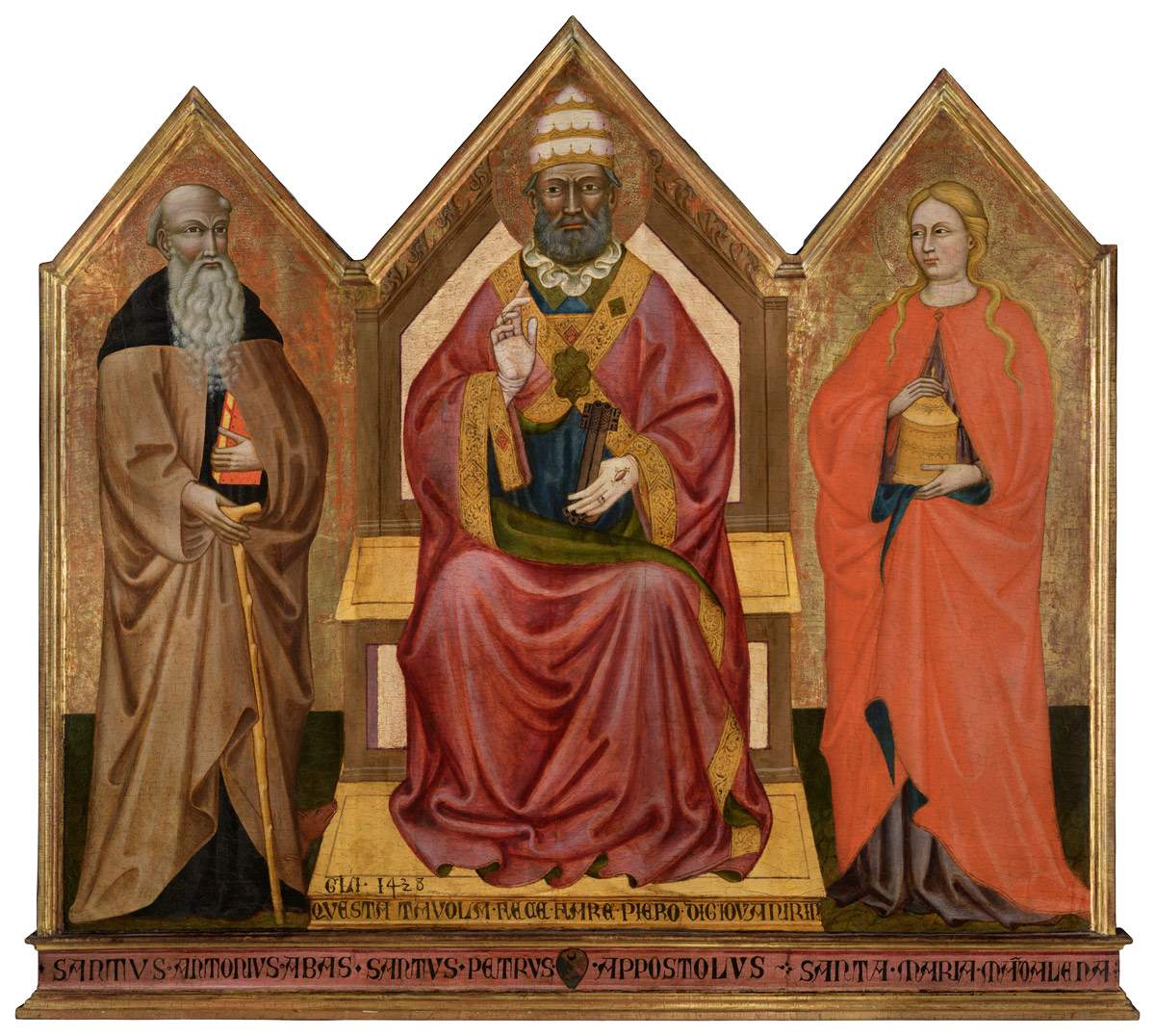
A popular seaside resort and a destination for lively summer tourism, Marina di Carrara is also the most populous hamlet in the municipality of Carrara, famous for its harbor from which marble leaves (one of the world’s main ports for the handling of marble and natural stone, but for some time now it has also served as a passenger port, being an intermediate stop for cruises), for its long beach of fine sand, but also for its waterfront and the harbor promenade, from which it is possible to enjoy a splendid view of the Apuan Alps and marble quarries, as well as to stop and watch romantic sunsets over the sea. A curiosity: in the nineteenth-century parish church of the Holy Family, which stands on the short side of the central Piazza Gino Menconi, you can admire four works of seventeenth-century Florentine art that have been here for decades on deposit from the Uffizi: the Madonna of the Rosary attributed to Jacopo Vignali, the Rest during the Flight into Egypt attributed to Anton Domenico Gabbiani, the Founding Saints of the Order of the Servants of Mary, a work attributed to Giovanni Domenico Ferretti, and the Saint Filippo Benizzi attributed to Francesco Curradi.

 |
| Carrara, what to see: the 10 places not to miss |
Warning: the translation into English of the original Italian article was created using automatic tools. We undertake to review all articles, but we do not guarantee the total absence of inaccuracies in the translation due to the program. You can find the original by clicking on the ITA button. If you find any mistake,please contact us.